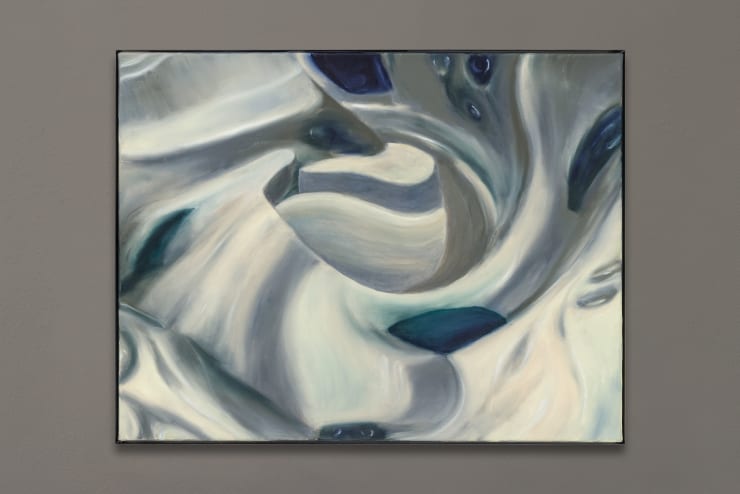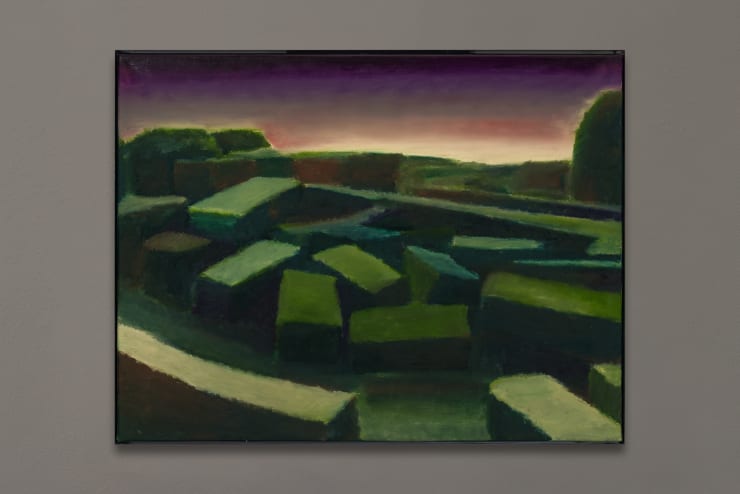Marc Henry: Tender Offer
“Postmodernism, postmodern consciousness, may then amount to not much more than theorizing its own condition of possibility, which consists primarily in the sheer enumeration of changes and modifications.”
– Fredric Jameson, Postmodernism, or, The Cultural Logic of Late Capitalism. 1991.
The German saying, ‘der Schein trügt’ defines a dichotomy in which something, once revealed, defies its original impression and therefore deceives. The initial assumption of the subject/object is made based off its first impression or surface-layer (whether conceptual or aesthetic), its shell: ‘All that glitters is not gold’.
In his solo exhibition Tender Offer, Marc Henry’s paintings reveal such tensions, drawing from the ever-proliferating peripheries of authenticity, inauthenticity and their mystification within our day-to-day relentless hyper capitalist machine. Revealing fragments of our strange postmodern reality, his works establish deceptive innuendos by exploring controversies in our current wellness, luxury and consumerist economy or by referencing historicised iconic cultural emblems such as the ancient relic the sphinx of Giza and Greek mythology such as Achilles. With an array of assertive steel-framed oil paintings at arm’s length, we bite the bullet and face fragments of a nuanced pastiche that reflect our idiosyncratic postmodern condition, or as critical theorist Frederic Jameson reiterates, ‘the cultural logic of late capitalism.’
We are reminded of Baudrillard’s Simulacra and Simulation, in which cultural tools of representation (both virtual and physical) ‘simulate’ our lived experiences when confronted with The Sphinx and Pyramid Scheme. For the technical process behind this work, Henry uploads an image found online of The Sphinx of the Seashore (1879) by Elihu Vedder, based on the statue of the Great Sphinx of Giza in Egypt constructed in around 2500 BC. He then edits this image within the programme DALL-E developed by OpenAI. This artificial intelligence generates digital images from language descriptions named ‘prompts.’ Infinitely removed from its original context, the reproduced image becomes obsolete – its authenticity called into question. Yet, by transferring the final rendition onto the canvas with thick, expressionistic oil strokes and framing the work with stainless steel, Henry solidifies its mutated presence in real-time, in the here and now. Before us is its sheer haptic corporeality.
In Society of the Spectacle, Guy Debord condemns consumer culture by building on the critique of commodity fetishism in Marx, asserting that ‘All that once was directly lived has become mere representation.’ Images circulating, proliferating and flowing through time within networks of capital are constantly disseminated, reconfigured, enhanced, adapted or replaced. Within the free flow of information, images become endless amorphous mutations that dextrously foreshadow signs and symbols aimed at the consumer yet also bring into question the authenticity and power or impact of an image.
Such is apparent in I Am Perpetually Haunted By a Future That Could Have Been, which depicts a mask that was initially welded and posted on a blog by an unknown welder living in eastern Europe, that was subsequently mistaken for being an authentic thirteenth-century bishop’s mask on twitter and subreddits. The image proliferated online across countless blogs and platforms until it was fallaciously historicised as it was published on multiple acclaimed history platforms on an international scale. Henry’s incorporation of photoshop and DALL-E further quantified and multiplied the initial image, with the final rendition translated into painterly form across the canvas. We are confronted with an arrangement of artificially generated masks whose eerie glitches remain captured in its expressionistic, physical, and painterly form.
The original rare ivory and diamond coated Russian Fabergé eggs symbolise ‘high-end’ luxury and have been swallowed up and incorporated into mainstream culture on a multifaceted scale, stressing ‘what the commodity had already shown itself to be in the course of this conquest: a process of quantitative development.’ In This Interregnum a Great Variety of Morbid Symptoms Appear, captures an online image of a 2008 Alexander McQueen ‘Fabergé egg purse’ which Henry subsequently rendered, generated and multiplied using photoshop and DALL-E. A photoshopped Venezuelan poodle moth furry in its texture sits amongst the contrastingly flat and reflective concoction of AI simulated Fabergé eggs.
Debord states that ‘the spectacle grasped in its totality is both the result and the project of the existing mode of production. It is not a supplement to the real world, an additional decoration. It is the heart of the unrealism of the real society. In all its specific forms, as information or propaganda, as advertisement or direct entertainment consumption, the spectacle is the present model of socially dominant life.’ Removed from its original function, the play on words of the title of the work Weapons of Mass Seduction, goes hand in hand with rendering the function of the object obsolete: Its fragile medium depicted as glass stressing its ornamental and alluring qualities. Contrasting tensions are further explored through the painterly technique that is required in order to depict the opacity of glass against the dense smoothly textured surface the object shines forth from.
Tender Offer reflects on the ever-conglomerating late-capitalist machine, our place within it and asks us to engage with what is beyond the alluring surface of our day-to-day goings on. The power of the ever-mutating dissemination of the image is further pulled into question, its absurdity made apparent. In the cultural logic of the present, we are faced with an ongoing uncomfortable truth: Nothing is what it seems, everything is but a pastiche and “In a world which really is topsy-turvy, the true is a moment of the false.”
Text: Sayori Radda
Marc Henry (* 1996 in Munich), lives and works in Vienna. The artist completed a diploma in fine painting at the Academy of Fine Arts in Vienna with Daniel Richter. He in addition graduated Cultural Economics at LMU Munich and SU Stockholm and Educating Curating Managing at the University of Applied Arts, Vienna.
Selected exhibitions include: About the New, Belvedere 21, Vienna (Upcoming 2023), Diploma Show, Academy of Fine Arts Vienna (2023), Anton Faistauer Prize for Painting, Galerie im Traklhaus, Salzburg (2023), Fiaskoflirt, Okay Works, Vienna (2022), Promesse Du Bonheur #2, MLZ Art Department, Trieste (2022) Wrong Answers only, Palais Rasumofsky, Vienna (2021)
-
 Marc HenryAchilles, 2023Öl auf Leinwand65 x 50 cm
Marc HenryAchilles, 2023Öl auf Leinwand65 x 50 cm
25 5/8 x 19 3/4 in -
 Marc HenryWellness Faktor x , 2023Öl auf Leinwand65 x 50 cm
Marc HenryWellness Faktor x , 2023Öl auf Leinwand65 x 50 cm
25 5/8 x 19 3/4 in -
 Marc HenryAll Pleasure Leads To Inner Decay, 2023Öl auf Leinwand50 x 65 cm
Marc HenryAll Pleasure Leads To Inner Decay, 2023Öl auf Leinwand50 x 65 cm
19 3/4 x 25 5/8 in -
 Marc HenryEverything You Like I Have Never Even Heard Of , 2023Öl auf Leinwand65 x 50 cm
Marc HenryEverything You Like I Have Never Even Heard Of , 2023Öl auf Leinwand65 x 50 cm
25 5/8 x 19 3/4 in -
 Marc HenryLiving Inside The Mind Of Somebody Who Lost , 2023Öl auf Leinwand50 x 65 cm
Marc HenryLiving Inside The Mind Of Somebody Who Lost , 2023Öl auf Leinwand50 x 65 cm -
 Marc HenryI Am Perpetually Haunted By a Future That Could Have Been, 2023Oil on Canvas50 x 65 cm
Marc HenryI Am Perpetually Haunted By a Future That Could Have Been, 2023Oil on Canvas50 x 65 cm
19 3/4 x 25 5/8 in -
 Marc HenryIn This Interregnum a Great Variety Of Morbid Symptoms Appear, 2023Oil on Canvas50 x 65 cm
Marc HenryIn This Interregnum a Great Variety Of Morbid Symptoms Appear, 2023Oil on Canvas50 x 65 cm
19 3/4 x 25 5/8 in -
 Marc HenryI’m Just As Confused As You Are, 2023Oil on Canvas50 x 65 cm
Marc HenryI’m Just As Confused As You Are, 2023Oil on Canvas50 x 65 cm
19 3/4 x 25 5/8 in -
 Marc HenryLost? Draw a Map, Then Paint the Picture, 2023Oil on Canvas50 x 65 cm
Marc HenryLost? Draw a Map, Then Paint the Picture, 2023Oil on Canvas50 x 65 cm
19 3/4 x 25 5/8 in -
 Marc HenryWeapons of Mass Seduction, 2023Oil on Canvas50 x 65 cm
Marc HenryWeapons of Mass Seduction, 2023Oil on Canvas50 x 65 cm
19 3/4 x 25 5/8 in -
 Marc HenryThe Sphinx and the Pyramid Scheme, 2023Oil on Canvas50 x 65 cm
Marc HenryThe Sphinx and the Pyramid Scheme, 2023Oil on Canvas50 x 65 cm
19 3/4 x 25 5/8 in -
 Marc HenryLooking for Fun, 2023Oil on Canvas50 x 65 cm
Marc HenryLooking for Fun, 2023Oil on Canvas50 x 65 cm
19 3/4 x 25 5/8 in -
 Marc HenryREM, 2023Oil on Canvas50 x 65 cm
Marc HenryREM, 2023Oil on Canvas50 x 65 cm
19 3/4 x 25 5/8 in
-
 Marc HenryInstallation View I, Tender offer, 2023
Marc HenryInstallation View I, Tender offer, 2023 -
 Marc HenryInstallation View, Tender Offer, 2023
Marc HenryInstallation View, Tender Offer, 2023 -
 Marc HenryInstallation View, Tender Offer, 2023
Marc HenryInstallation View, Tender Offer, 2023 -
 Marc HenryInstallation View, Tender Offer, 2023
Marc HenryInstallation View, Tender Offer, 2023 -
 Marc HenryInstallation View, Tender Offer, 2023
Marc HenryInstallation View, Tender Offer, 2023 -
 Marc HenryInstallation View, Tender Offer, 2023
Marc HenryInstallation View, Tender Offer, 2023 -
 Marc HenryInstallation View, Tender Offer, 2023
Marc HenryInstallation View, Tender Offer, 2023 -
 Marc HenryInstallation View, Tender Offer, 2023
Marc HenryInstallation View, Tender Offer, 2023 -
 Marc HenryInstallation View, Tender Offer, 2023
Marc HenryInstallation View, Tender Offer, 2023























